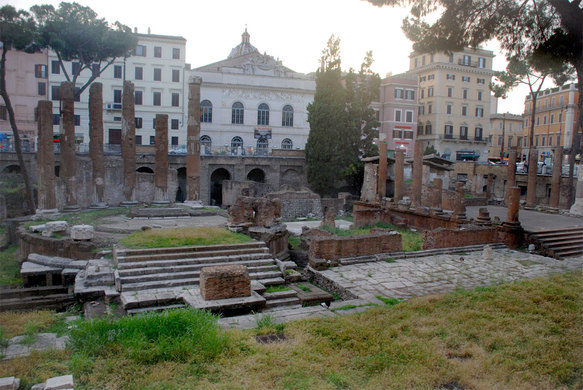Move Aside Feral Cats! The ruins in the Largo di Torre Argentina are about to get a fashion make-over.
The location of the murder of Julius Caesar will soon be renovated, it has been recently announced. It was over 2,000 years ago on this day, The Ides of March, also known as March 15th, that famous Roman politician, General and historian was assassinated in the Theater of Pompey. Caesar was brutally stabbed to death 23 times by 60 members of the senate as a consequence of his growing power and influence. It was thought that he was a threat to the Republic itself, and yet, it was only after his death that the empire took hold.

Assassination of Caesar by William Holmes Sullivan, c. 1888, Royal Shakespeare Theatre
Now, the very interesting thing is that the location of this assassination is not where you might automatically think. Indeed, it was very ironic that Caesar died on the portico of a public work done by Pompey. (You may remember that Pompey, once Rome’s most accomplished general had, notably, been defeated by Caesar in a civil war and then murdered in Egypt by Caesar’s allies.)
You see, the Roman senate did not usually meet at Pompey’s Theater. Instead they had for centuries congregated at the Curia, or meeting house on the Comitium. Despite numerous fires, restorations and rebrandings, this was always Rome’s primary open air meeting location.
However, in 52 B.C. Publius Clodius Pulcher was killed by his political rival and his enthusiastic followers concluded that they needed to cremate Publius in the senate house, incinerating the entire place in the process.
Consequently, Caesar started constructing a new senate house. But while the ‘Curia Julia’ was being built, the senate moved temporarily to the Curia Pompeiana, part of Pompey the Great’s massive public theater.
The location of the death of Caesar, forever immortalized by historians and Shakespeare, was sadly covered up by the expansion of Rome and lost until the 1920’s. This is when the Italian dictator Mussolini undertook numerous archeological endeavors as part of a propaganda project to boost Italian nationalistic efforts, including uncovering the theater of Pompey and four temples. However, after World War II, many of these sites were left unattended… and recent economic woes have resulted in greater disrepair.

The current site of Caesar’s death, Largo di Torre Argentina
Fortunately the fashion house Bulgari, in a bizarre but exciting partnership, have decided to step in and contribute $1.1 million in funding the clean up and restoration. This isn’t even the first time… Bulgari has already paid $1.6 million to restore Rome’s Spanish steps. In fact, the city of Rome has been partnering with several luxury brands in efforts to preserve many of the iconic sites. For instance, fashion house Fendi aided the clean up of the Trevi Fountain while Tods funded half of the massive restoration of the Colosseum, which reopened in 2016.
With this unlikely source of revenue, we can expect a beautifully renovated walkways surrounding the ruins, which no doubt, will double as runways.









No comments
Trackbacks
Our apologies, you must be logged in to post a comment.